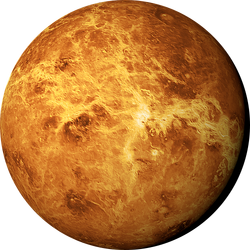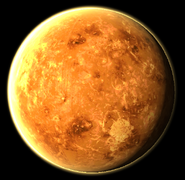| Venus | |
|---|---|

| |
| Number of Sattelites | None (1 hypothetical satellite called Neith) |
| Atmospheric Makeup | 96.5% carbon dioxide 3.46% nitrogen 0.0145% sulfur dioxide |
| Distance from Sun | 67.2 million miles |
| Diameter | 7565 miles 12,104 kilometers |
| Axial tilt | 177.3 degrees |
| Orbit | 224 days |
| Position in Solar System | Second planet from Sun |
| Surface Features | Mainly volcanism and valleys |
| Albedo | (geometric) 0.67 (bond) 0.9 |
| Aphelion | 68.09 million miles |
| Perihelion | 67.17 million miles |
| Mass of Planet | 4.87 x 1024 kg |
| Escape Velocity | 10.4 kilometers/second |

Venus is the second planet from the Sun. Venus is the hottest planet in the Solar System, though it is not the closest to the Sun, in which said title goes to the planet Mercury. The reason that this planet is hot is due to Venus' dense atmosphere. In fact, Venus has the densest atmosphere of the inner planets, and due to this atmosphere, it traps several greenhouse gases, heating the planet. Due to its similar size, structure, and mass, Venus is sometimes referred to as Earth's sister planet. Also due to Venus being the closest planet to Earth. After the Earth's moon, Venus is the brightest object the night sky.
Formation
Since Venus is a rocky planet, it was created in a place close to the Sun. Accretion fused the nebula together tightly and created this rocky planet. Venus did not have a bombardment period though. While Venus was being created and because it was so hot at birth, Venus shrunk due to the amount of heat, similar to that of its neighboring planet, Mercury.
Atmosphere
Venus' atmosphere is mostly made of carbon dioxide which heats the atmosphere. This causes the greenhouse effect, which makes Venus the hottest planet in the Solar System. The temperature of Venus can reach nine hundred degrees Fahrenheit. Due to the combination of gases, Venus rains sulfuric acid from the atmosphere, which can also ignite many lava oceans, sending gases into the air, contributing to the density of the atmosphere. Due to the dense atmosphere, Venus' atmospheric pressure is more than ninety times that of Earth, contributing to a large amount of rock formation of the surface and no carbon cycle.
Venus's atmosphere is 96.5 percent carbon dioxide, which contributes to a lot of the heating of Venus. The rest is made up of 3.5 percent nitrogen. Other trace gases include neon, helium, carbon monoxide, etc.
Surface Features
Many surface features are found on the surface of Venus, including volcanoes, rivers filled with lava, and many other features that contribute to the heating, the denseness of the atmosphere, and many other factors. Volcanic plains are common on the surface, which also contribute to the amount of sulfur located in the atmosphere. Few impact craters are located on the ground, for due to the thick atmosphere, very few comets and asteroids have collided with Venus. The atmosphere stopped these asteroids very well, however, for the impact craters are no more in diameter than three miles.
Pictures
| The Planets and Dwarf Planets | |
|---|---|
| Planets | |
| Mercury • Venus • Earth • Mars • Jupiter • Saturn • Uranus • Neptune | |
| Dwarf Planets | |
| Ceres • Pluto • Haumea • Makemake • Quaoar • Eris | |


